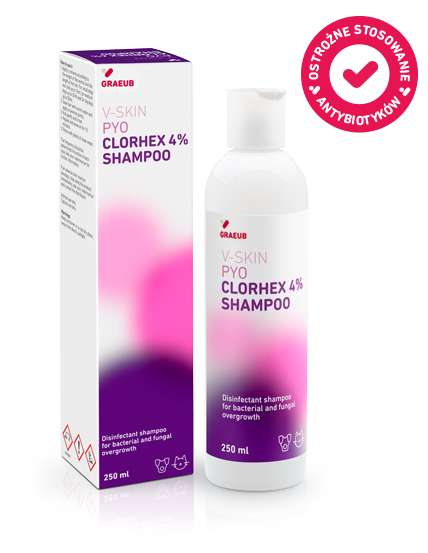Wspomaganie leczenia zakażeń skóry
Wspomaganie leczenia zakażeń skóry
V-SKIN
PYO
CLORHEX 4% SHAMPOO
Skuteczny preparat o działaniu miejscowym to podstawa w zwalczaniu bakteryjnych i grzybiczych zakażeń skóry u kotów i psów.
Szampon Clorhex 4% ma właściwości dezynfekujące, antybakteryjne i przeciwgrzybicze – oczyszcza skórę i rany w przebiegu zapalenia skóry i ropnego zapalenia skóry.
Zawiera hipoalergiczne substancje zapachowe i nie zawiera siarczanów; zmniejsza suchość skóry i pielęgnuje skórę zwierzęcia. Zawartość delikatnego mydła naturalnego z oleju kokosowego sprawia, że sierść jest czysta i miękka.

Najważniejsze kwestie:
- Zawiera chlorheksydynę – skuteczny środek antybakteryjny, dezynfekujący i antyseptyczny.1, 2, 3, 4
- Tris-EDTA: składnik zapobiegający tworzeniu się biofilmu, który wzmacnia działanie chlorheksydyny.5, 6, 7
- Aloes i nagietek łagodzą i koją uszkodzoną skórę.8, 9, 10, 11, 12, 13, 14, 15, 16, 17, 18
Sposób użycia:
- Nałożyć odpowiednią ilość zależnie od masy ciała i długości sierści zwierzęcia.
- Zmoczyć sierść ciepłą wodą i nałożyć produkt w kilku miejscach.
- Delikatnie wetrzeć i spłukać.
- Powtórzyć i pozostawić na 10 minut.
- Spłukać dużą ilością czystej wody.
- Częstość stosowania należy ustalić zależnie od danego przypadku.
- Należy skonsultować się z lekarzem weterynarii.
- Unikać kontaktu z oczami.
Obejrzyj materiał wideo dotyczący stosowania produktu!
Opinie lekarzy weterynarii
Pleasant smell, leaves a fluffy hair and skin erythema is relieved after use.

Bibliografia
- Mueller, R. S., Bergvall, K., Bensignor, E., & Bond, R. (2012). A review of topical therapy for skin infections with bacteria and yeast. Veterinary Dermatology, 23(4).
https://doi.org/10.1111/j.1365-3164.2012.01057.x - Denny, J., & Munro, C. L. (2017). Chlorhexidine Bathing Effects on Health-Care-Associated Infections. Biological Research for Nursing, 19(2).
https://doi.org/10.1177/1099800416654013 - Esumi, M., Kanda, S., Shimoura, H., Hsiao, Y. H., & Iyori, K. (2021). Preliminary evaluation of two bathing methods for the management of Malassezia overgrowth in dogs with atopic dermatitis. Veterinary Dermatology, 32(3).
https://doi.org/10.1111/vde.12948 - Wan, J. (2014). A case of methicillin-resistant Staphylococcus pseudintermedius (MRSP) pyoderma in a Labrador retriever dog. Canadian Veterinary Journal, 55(11).
- Swanson, E. A., Freeman, L. J., Seleem, M. N., & Snyder, P. W. (2014). Biofilm-infected wounds in a dog. Journal of the American Veterinary Medical Association, 244(6).
https://doi.org/10.2460/javma.244.6.699 - Wooley, R. E., & Jones, M. S. (1983). Action of EDTA-Tris and antimicrobial agent combinations on selected pathogenic bacteria. Veterinary Microbiology, 8(3).
https://doi.org/10.1016/0378-1135(83)90079-2 - Buckley, L. M., Mcewan, N. A., & Nuttall, T. (2013). Tris-EDTA significantly enhances antibiotic efficacy against multidrug-resistant Pseudomonas aeruginosa in vitro. Veterinary Dermatology, 24(5).
https://doi.org/10.1111/vde.12071 - Hekmatpou, D., Mehrabi, F., Rahzani, K., & Aminiyan, A. (2019). The effect of aloe vera clinical trials on prevention and healing of skin wound: A systematic review. In Iranian Journal of Medical Sciences (Vol. 44, Issue 1).
- Sánchez, M., González-Burgos, E., Iglesias, I., & Gómez-Serranillos, M. P. (2020). Pharmacological update properties of aloe vera and its major active constituents. In Molecules (Vol. 25, Issue 6).
https://doi.org/10.3390/molecules25061324 - Teplicki, E., Ma, Q., Castillo, D. E., Zarei, M., Hustad, A. P., Chen, J., & Li, J. (2018). The effects of aloe vera on wound healing in cell proliferation, migration, and viability. Wounds, 30(9).
- Kamr, A., Arbaga, A., El-Bahrawy, A., Elsify, A., Khaled, H., & Hassan, H. (2020). The therapeutic efficacy of Aloe vera gel ointment on staphylococcal pyoderma in dogs. Veterinary World, 13(11).
https://doi.org/10.14202/VETWORLD.2020.2371-2380 - Arbaga, A., El-Bahrawy, A., Elsify, A., Khaled, H., Hassan, H. Y., & Kamr, A. (2021). Biochemical and histopathological changes related to the topical application of Aloe vera ointment for canine pyoderma. Veterinary World, 14(5).
https://doi.org/10.14202/vetworld.2021.1354-1362 - Preethia, K. C., Kuttanb, G; Kuttan, R. (2009). Anti-inflammatory activity of flower extract of Calendula officinalis Linn. and its possible mechanism of action. Indian Journal of Experimental Biology 2009 47(2).
- Tresch, M., Mevissen, M., Ayrle, H., Melzig, M., Roosje, P.; Walkenhorst, M. (2019). Medicinal plants as therapeutic options for topical treatment in canine dermatology? A systematic review. BMC Veterinary Researc, (1).
https://doi.org/10.1186/s12917-019-1854-4 - Giostri, G. S., Novak, E. M.; Guarita-Souza, L. C. (2021). Treatment of acute wounds in hand with Calendula officinalis L.: A randomized trial. Tissue Barriers.
https://doi.org/10.1080/21688370.2021.1994822 - Cruceriu, D., Balacescu, O; Rakosy, E. (2018). Calendula officinalis: Potential Roles in Cancer Treatment and Palliative Care. In Integrative Cancer Therapies (Vol. 17, Issue 4, pp. 1068–1078). SAGE Publications Inc.
https://doi.org/10.1177/1534735418803766 - Lima, M. dos R., Lopes, A. P., Martins, C., Brito, G. A. C., Carneiro, V. C; Goes, P. (2017). The effect of Calendula officinalis on oxidative stress and bone loss in experimental periodontitis. Frontiers in Physiology, (JUN).
https://doi.org/10.3389/fphys.2017.00440 - John, R.; Jan, N. (2017). Calendula Officinalis-An Important Medicinal Plant with Potential Biological Properties.Proceedings of the Indian National Science Academy,(0).
https://doi.org/10.16943/ptinsa/2017/49126


 Używamy plików cookie na naszej stronie internetowej, aby zapewnić Ci najbardziej odpowiednie wrażenia poprzez zapamiętywanie Twoich preferencji i powtarzanie wizyt. Klikając „Akceptuj”, użytkownik wyraża zgodę na używanie WSZYSTKICH plików cookie. Możesz jednak odwiedzić Ustawienia plików cookie, aby wyrazić kontrolowaną zgodę.
Używamy plików cookie na naszej stronie internetowej, aby zapewnić Ci najbardziej odpowiednie wrażenia poprzez zapamiętywanie Twoich preferencji i powtarzanie wizyt. Klikając „Akceptuj”, użytkownik wyraża zgodę na używanie WSZYSTKICH plików cookie. Możesz jednak odwiedzić Ustawienia plików cookie, aby wyrazić kontrolowaną zgodę.